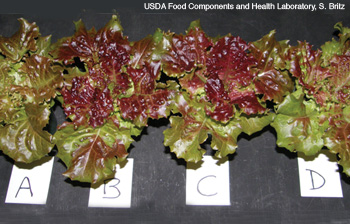Scatterings
Ultraviolet LEDs Enhance Lettuce Nutrients
Sientists have found that applying supplemental ultraviolet-B radiation to red-leaf lettuce increases the production of polyphenolic compounds and possibly the storage lifetime of the chemicals.
 Exposing red-leaf lettuce to UV-LED lights results in an enhanced red “tan” from anthocyanin accumulation. Plants were exposed continuously for 48 hours at 23° C at 10 mW m-2 with background low-pressure sodium illumination: (a) unexposed control plant, (b) 282 nm light, (c) 296 nm light and (d) 308 nm light.
Exposing red-leaf lettuce to UV-LED lights results in an enhanced red “tan” from anthocyanin accumulation. Plants were exposed continuously for 48 hours at 23° C at 10 mW m-2 with background low-pressure sodium illumination: (a) unexposed control plant, (b) 282 nm light, (c) 296 nm light and (d) 308 nm light.
Can exposing our food to low-energy light-emitting diodes (LEDs) improve its nutritional quality? A new report from the U.S. Department of Agriculture (USDA) says yes. Greenhouse cultivation allows high-quality, local produce all year long, but most greenhouse coverings filter out the short ultraviolet wavelengths from the solar spectrum, decreasing the synthesis and accumulation of some nutrients.
…Log in or become a member to view the full text of this article.
This article may be available for purchase via the search at Optica Publishing Group.
Optica Members get the full text of Optics & Photonics News, plus a variety of other member benefits.
